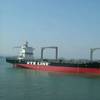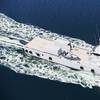ABS Updates Naval Ships Guide
ABS has updated its Guide for Building and Classing International Naval Ships (INS Guide), expanding its guidance to strengthen safety and protection against a range of threats.
“ABS is a world leader in naval classification and our 2019 INS Guide takes this to the next level,” said ABS Senior Vice President for Global Government, James Watson. “Naval vessels face an increasingly sophisticated range of threats and the ABS guidance is evolving to keep pace with the challenges they face, supporting more reliable and mission-ready fleets.”
The Guide features new sections on Mission Threats Protection which consist of new notations to demonstrate a vessel meets the Allied Naval Engineering Publication (ANEP) 77 standard, as well as Ballistics, Fragmentation, and Air Blast protection.
The notations respond to requests from navies around the world and are now being offered for a range of combatant and non-combatant vessels.
The new ABS NavalSafe notation determines safety and performance standards for government combatant and non-combatant vessels in line with the North Atlantic Treaty Organization’s Naval Ship Code. Compliance with the code allows governments to learn from international best practice, realize cost-effective regulation and demonstrate commitment to achieving greater levels of safety to stakeholders.
A new chapter on Ballistics and Fragmentation introduces technical guidance for achieving a level of protection for Naval ships against direct fire weapons, based on the mission requirements, anticipated threats and results of vulnerability assessments. Naval ships complying with this chapter may be issued an optional BFP1, BFP2, or BFP3 notation, depending on the level of protection applied to the vessel. Such notations are private, ensuring details of a vessel’s protection remain confidential.
The Air Blast guidance provides a methodology for analyzing vessel structure for the desired level of protection, including blast pressure and resistance curves enabling designers to quickly assess the impact of different scenarios. The Guide also contains examples to help the user better understand this complex issue.






